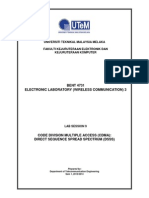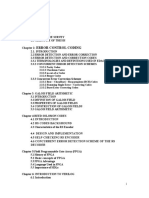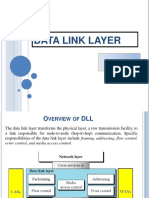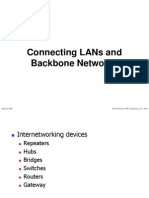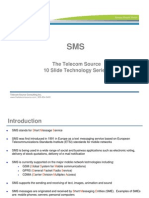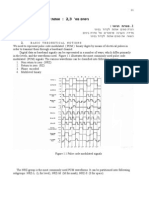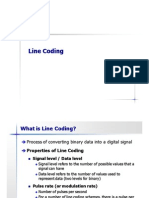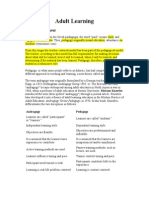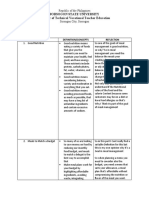RZ Ami
RZ Ami
Uploaded by
Jorge Deza ConcoriCopyright:
Available Formats
RZ Ami
RZ Ami
Uploaded by
Jorge Deza ConcoriOriginal Description:
Original Title
Copyright
Available Formats
Share this document
Did you find this document useful?
Is this content inappropriate?
Copyright:
Available Formats
RZ Ami
RZ Ami
Uploaded by
Jorge Deza ConcoriCopyright:
Available Formats
11
: 2,3 '
: .1
2. B A S I C T H E O R E T I C A L N O T I O N S
We need to represent pulse code modulated ( PCM ) binary digits by means of electrical pulses in
order to transmit them through a baseband channel.
Digital data as baseband signals can be represented in a number of ways, which differ primarily in
the levels, and the waveforms used. Figure 1.1 illustrates the most commonly used pulse code
modulated (PCM) signals. The various waveforms can be classified into following groups:
1. Non return to zero (NRZ)
2. Return to zero (RZ)
3. Phase encoded
4. Multilevel binary
Figure 1.1 Pulse code modulated signals
The NRZ group is the most commonly used PCM waveforms. It can be partitioned into following
subgroups: NRZ-L (L for level), NRZ-M (M for mark), NRZ-S (S for space).
12
NRZ-L is used extensively in digital logic. A binary one is represented by one level and a binary
zero is represented by another level. The level changes whenever the data changes from one to
zero or from zero to one. Any change in level occurs at the positive transition of clock-signal.
With NRZ-M, the one, or mark, is represented by a change in level, and the zero, or space, is
represented by no change in level. NRZ-M is used primarily in magnetic tape recording. NRZ-S is the
complement of NRZ-M : a one is represented by no change in level, and a zero is represented by a
change in level.
Figure 1.2 illustrates a circuit to decoding NRZ-L waveforms.
input signal
NRZ waveform
data
D-flip-flop
receiver
clock
clock
Figure 1.2
The RZ waveforms consist of unipolar-RZ, bipoloar-RZ, and RZ-AMI. With unipolar RZ, a half-bitwide pulse represents a one, and a zero is represented by absence of pulse. With bipolar RZ
opposite-level pulses that are one-half-bit wide represent the ones and zeros. There is a pulse
present in each bit interval. RZ-AMI (AMI for alternate mark inversion) is the coding most often used
in telemetry systems. Equal-amplitude alternating pulses represent the ones. The zeros are
represented by absence of pulses.
Gating the basic NRZ-L signal with clock-signal can generate the RZ-L waveforms.
Figure 1.3 illustrates RZ-L waveforms and circuits for coder and decoder.
CLOCK SIGNAL
DATA SIGNAL
0
DATA SEQUENCE
a) RZ waveforms
NRZ in
RZ out
Clock in
b) RZ encoder
RZ in
Data Data
Receiver clock
D Flip-FlopD Flip-Flop
Monostable
multivibrator
Clock Clock
Tb/4
c) RZ decoder
Figure 1.3
NRZ out
13
A typical encodes circuit for RZ-AMI and typical waveforms generated during the encoder circuit
operation are shown in Fig. 1.4. The encoder uses a memory element, the JK flip-flop, - to remember
the polarity of the last transmitted one and thereby determine the polarity of the current one.
Figure 1.4 Typical AMI encoding circuit
14
Figure 1.4.b AMI coder waveforms
First rectifying, to obtain the equivalent RZ form, and then decoding by means of the RZ decoder
circuit carry out the decoding of AMI waveforms. A typical AMI decoder is shown in Fig.1.5.
RZ waveform
AMI signal
Full-wave
Rectifier
NRZ data
D-flip-flop
Regenerated
Clock
Multivibrator
Clock
Figure 1.5 Typical AMI decoder
The phase-encoded group consists of Bi--L ( bi-phase-level ), which known as Manchester
coding; Bi--M (bi-phase-mark); Bi--S ( bi-phase-space ); and delay modulation (DM), or Miller
coding. The phase-encoding schemes are used in magnetic recording systems and optical
communications and in some satellite telemetry links. With Bi--L, a one is represented by a half-bitwidth pulse positioned during the first half of the bit interval; a half-bit-wide pulse positioned during the
second half of the bit interval represents a zero. With Bi--M, a transition occurs at the beginning of
every bit interval. A one is represented by a second transition one-half-bit interval later; a zero is
represented by no second transition. With Bi--S , a transitions also occur at the beginning of every bit
interval. A one is represented by no second transition; a zero is represented by a second transition
one-half-bit interval later. With Delay modulation, a one is represented by a transition at the midpoint
15
of the bit interval. A zero is represented by no transition, unless it is followed by another zero. In
this case, a transition is placed at the end of bit interval of the first zero.
A typical encoder/decoder circuit is shown in Fig. 1.6.
clock signal
data sequence 1
data signal
a) Bi-phase waveforms
data input
output
clock input
b) Be-phase encoder / dec
oder
Figure 1.6 Bi-phase codin
Some of waveforms use three levels to encode the binary data. Bipolar RZ and RZ-AMI belong to this
group. The group also contains formats called Dicode and Duobinary. With Dicode-NRZ , the oneto zero or zero-to one data transition changes the pulse polarity; without a data transition, the zero
level is sent. With Dicode-RZ, the one-to zero or zero-to-one transition produces a half-duration
polarity change; otherwise, a zero level is sent. Three-level duobinary signaling will be learned in next
laboratory work.
A way to reduce bandwidth is to use multilevel signaling. Consider a binary PCM bit stream with
data rate R bits per second. Instead of transmitting a pulse waveforms for each bit, we first partition the
data into k-bit group. We then use M 2 k -level pulses for transmission. Each pulse waveforms can
now represent a k-bit symbol in a symbol stream of rate R/k symbols per second.
As an example, let us analyze a four-level system (Fig.1.7). The transmitter consist of a shift register, in
this case having one stage, followed by an encoder, which encodes two bits at a time (the bit stored in
the shift register and the bit presently applied to the transmitter input). The encoder outputs symbols
with duration of two input bit intervals; therefore the output symbol rate is half the input bit rate. Note
that the information transfer rate remains constant. Transmitter imposes a delay of one bit between
input and output sequences.
The receiver decodes the received sequence by detecting the voltage range occupied by incoming
signal at the sampling instant, and generating a two-bit word which corresponds to the symbol whose
nominal level is contained in the previously mentioned voltage range. These voltage ranges can be
identified in Figure 1.7, waveforms D.
A
Clock
Divider (:2)
C
16
One-bit
shift
register
Input
Sequence
(NRZ)
D
Encoder
to transmission
channel
1) Transmitter block diagram
Data
B
C
(11)
D
(10)
(01)
(00)
b) Typical waveforms
Figure 1.7 multilevel signaling
The common criteria used for comparing PCM waveforms and for selecting one waveforms type from
many available are:
1. DC component. Eliminating the dc energy from the signals power spectrum enables the system
to be ac coupled. Magnetic recording systems, or systems using transformer coupling, has little
sensitivity to very low frequency signal components. Thus low-frequency information could be
lost.
2. Self - Clocking. Symbol or bit synchronization is required for any digital communication system.
Some PCM coding schemes have inherent synchronizing or clocking features that aid in the
recovery of clock- signal. For example, the Manchester code has a transition in the middle of
every bit interval whether a one or a zero is being sent.
3. Error detection. Some schemes, such as duobinary, provide the means of detecting data error
without introducing additional error- detection bits into the data sequence.
4. Bandwidth compression. Some schemes, such as multilevel codes, increase the efficiency of
bandwidth utilization by allowing a reduction in required bandwidth for a given data rate.
5.
Differential encoding. This technique is useful because it allows the polarity of differentially
encoded waveforms to be inverted without affecting the data detection. In communication
systems where waveforms sometimes experience inversion, this is a great advantage.
17
6.
Noise immunity. The various PCM waveform types can be characterized by probability of bit
error versus signal-to-noise ratio. Some of the schemes are more immune than other to noise. For
example, the NRZ waveforms have better error performance than does the unipolar RZ
waveforms.
The important characteristic of signal is spectral characteristic. The spectral characteristic of PCM
waveforms establishes the required system bandwidth and indicates how efficiently the bandwidth is
being used. Figure 1.8 shows the spectral characteristics of some of the most popular PCM waveforms.
The figure plots power spectral density in watts/hertz versus normalized bandwidth (frequency times
pulse width).
3. E X P E R I M E N T A L W O R K
NRZ code, RZ code, AMI code, Bi--code, multilevel coding
3.1 Familiarization with pseudo-random sequence generator
18
.
1.
Select a data rate of 8 kb/sec, with sequence length of 2 4 -1.
b. Connect channel 1 of oscilloscope to the DATA OUT of the data generator and channel 2 to the 8
kHz CLOCK AND CARRIER output. Connect the external trigger input of the oscilloscope to the
SYNC OUT. Adjust the trigger controls to obtain a stable, clear display. Draw timing diagrams of
data sequence and clock signal, record bit sequence.
3. Repeat steps a. and b. and observe form of data sequence for data rate from 16 to 64 kb/sec.
Note that clock signal must be matching to data rate.
4.
Set data rate of 16 kb/sec with sequence length of 2 8 -1. Observe the form of data sequence.
The longer sequence can be conveniently examined by expanding the horizontal display.
3.2 NRZ (non return to zero) CODE
Pseudo-random sequence generator generates data sequence in NRZ form ( NRZ-encoded).
A basic characteristics of data sequence represented by baseband codes are: duration and shape of
signal which represents one or zero, number of signals levels, average of DC component, number
of transitions. In addition, to select baseband code we must pay attention to communication reliability
and equipment complexity.
CODE CHARACTERISTICS
a. Select a data rate of 16 kb/sec.
2. Use the oscilloscope to observe the phase relationship between the 16 kHz clock signal and NRZencoded signal.
c. Measure the average DC component accompanying the data signal for both the 2 4 -1 and 2 8 -1
sequences.
NRZ REGENERATION
a. Connect the data signal with data rate of 8 kb/sec to the DATA IN of NRZ regenerator and 8 kHz
clock signal to CK IN of NRZ regenerator.
b. Compare the data waveforms appearing at the NRZ OUT of regenerator with the original data
sequence.
3. Connect the data signal (DATA OUT of data generator) to DATA IN of BASEBAND LOWPASS
FILTER, than connect the DATA OUT of low-pass filter to DATA IN of NRZ regenerator.
Observe and draw timing diagrams for all connection points on the pass of signal (from source of
data sequence to output of regenerator). Pay attention on phase relations.
d. Repeat step c. for data rate from 16 to 64 kb/sec. Pay attention on output signal of low pass
filter, which imitates a communication channel. Draw timing diagrams.
19
e. Select the data rate of 8 kb/sec. Turn switch of noise generator to on. Set level of noise by
means of potentiometer equal to 0.5 V rms. Observe timing diagrams on pass of signal.
6.
Repeat step e. for data rate from 16 to 64 kb/sec.
g. Set level of noise equal to 1.5-2 V rms and repeat steps e. and f.
To obtain proper regeneration, it may be necessary to use clock-signal inversed by phase.
1.1.
RZ (return to zero) code
CODE CHARACTERISTICS
1.
Select a data rate of 8 kb/sec.
2.
Connect the data signal to NRZ IN of the RZ encoder and appropriated clock-signal to CK
IN of RZ encoder.
3. Use the oscilloscope to compare the NRZ and RZ waveforms, draw timing diagrams.
d. Measure the average DC component of RZ encoded sequence.
RZ DECODING
1. Assemble the setup shown in Fig. 1.9
2.
Select a data rate of 8 kb/sec.
c. Observe waveforms on pass of signal from data generator to output of RZ/NRZ
regenerator. Draw waveforms.
d. Repeat step c. for data rate from 16 to 64 kb/sec. Pay attention on output signal of lowpass filter and to phase relations between signal from source and output signal of regenerator.
5.
Data
Turn switch of noise generator to on. Observe influence of noise on waveforms at all
points of signal pass.
NRZ
20
Generator
(data out)
RZ
encoder
Baseband
Low pass
Filter
clock
RZ / NRZ
Regenerator
NRZ
f
Clock &
Carrier
Generator
90
Phase
Shifter
2f
Figure 1.9. RZ coding and decoding
Data
Generator
NRZ
(data out)
Clock
and
Carrier
Generator
90
Phase
Shifter
2f
Figure 1.10 AMI encoder
Attention! The clock frequency must be equal to bit rate.
1.2.
AMI (alternate mark inversion) code
CODE CHARACTERISTICS
Clock
AMI
Encoder
AMI
21
1.
Select a data rate of 8 kb/sec
2.
Assemble the setup shown in Fig.1.10
c. Check the operation of the 90 0 phase shifter (Unit DIGICOM I / I ). Draw the
corresponding timing diagram.
4.
Use the oscilloscope to compare the NRZ and AMI waveforms, draw timing diagram.
5.
Measure the average DC component of AMI encoded sequence.
AMI DECODING
1.
Select a data rate of 16 kb/sec.
2.
Put the AMI-encoded sequence to AMI IN of the AMI regenerator ( Unit
DIGICOM I/2). Connect the CK IN of regenerator to 16 kHz output of clock and
carrier generator (put clock signal of negative polarity. It is marked by 16 ).
Draw timing diagram, showing the waveforms at all interconnection points on the
pass of signal from the signal source to output of regenerator.
3.
3.5 BI-PHASE (Manchester I I ) CODE
CODE CHARACTERISTICS
a. Select a data rate of 8 kb/sec.
2.
Connect the data signal to NRZ IN of the bi-phase encoder (contained on unit
DIGICOM I / I.). Put clock signal to CK IN of the bi phase encoder.
3.
Compare the NRZ and bi-phase waveforms, draw timing diagrams.
4.
Measure the average DC component of BI-PHASE encoded sequence.
BI - PHASE DECODING
1.
Connect the BI- IN(put) of decoder to the output of the encoder. Connect
appropriate clock signal to CK IN(put) of decoder.
2.
Draw timing diagrams of NRZ-sequence from source, sequence of clock-signals, BI encoded sequence, BI- decoded sequence. Pay attention on phase relations.
3.6 MULTI-LEVEL BASEBAND CODE
22
FOUR-LEVEL ENCODER
Select a data rate of 16 kb/sec and a sequence length of 2 4 -1 bits.
1.
1.
1.
Connect DATA OUT of data generator to DATA IN of four-level encoder contained
on unit DIGICOM-1 / 3. Connect 16 kHz clock-signal to CK IN of encoder.
Use the oscilloscope to compare the NRZ and the four- level waveforms. Draw
timing diagram of NRZ and FOUR -LEVEL encoding sequences. Pay special
attention to the average time between the zero crossing of four-level waveforms. For
comparison we needs in twice time of NRZ sequence.
Measure the average DC component of the four-level encoding sequence.
FOUR - LEVEL DECODER
1.
1.
Connect the 4- LEVEL OUT of the encoder to input of the four-level regenerator.
Connect 8 kHz clock signal to the CK/2 IN and 16 kHz clock signal to the CK IN of
regenerator.
Make decoding of the sequence. Put into accordance every level of four level encoded
signals to pair of bits from signal source. Draw timing diagrams. Pay attention to
phase relations.
: ''
Control questions:
1. Principles of baseband coding.
2. Explain what are demands for code elements. Give examples for representation of
binary code elements.
3. NRZ codes. Common properties.
4. NRZ-L code. Frame diagrams of devices which produce coding and decoding.
5. RZ codes. Common properties.
6. Time diagram of RZ-L coded sequence. Frame diagram of devices produced RZ-L
coding and decoding.
7. AMI codes. Common characteristics.
8. Group of phase encoded baseband signals. Common properties.
9. Bi-Phase-L coding. Waveforms, encoder, decoder.
10. Multilevel coding. Common characteristics of multilevel codes.
.1
.2
.3
.4
.5
.6
23
11.
1.
What is criterion to compare a baseband codes.
Compare NRZ, RZ, AMI, BI-PHASE and MULTI-LEVEL codes with regard to
basically characteristics.
1. Analyze the influence of a communication channel without noise (low pass filter)
on the signal waveforms and on decoding.
You might also like
- 2016 Surgical Techniques in Otolaryngology, HEAD and NECK SURGERYDocument311 pages2016 Surgical Techniques in Otolaryngology, HEAD and NECK SURGERYHaidir Muhammad75% (8)
- Huffman Coding On MatlabDocument8 pagesHuffman Coding On Matlabboss_bandorNo ratings yet
- Solutions To Problems Related To Information TheoryDocument4 pagesSolutions To Problems Related To Information TheoryRohit BhadauriaNo ratings yet
- Lab 9 Cdma DsssDocument6 pagesLab 9 Cdma DsssFarEast RamdzanNo ratings yet
- Book BELATTARDocument11 pagesBook BELATTARazer31rrNo ratings yet
- Matlab Code For NRZDocument1 pageMatlab Code For NRZHRISHIKESH E BNo ratings yet
- Fast Frequency Hopping Slow Frequency Hopping Spread Final For The DayDocument27 pagesFast Frequency Hopping Slow Frequency Hopping Spread Final For The DayNaveed RamzanNo ratings yet
- LZW Encoding and DecodingDocument18 pagesLZW Encoding and DecodingSrinathNo ratings yet
- Chapter 7. W-CDMA TechnologyDocument31 pagesChapter 7. W-CDMA Technologyfaditele4No ratings yet
- Propagation Models Used in Planning: The Hata Model For Suburban AreasDocument4 pagesPropagation Models Used in Planning: The Hata Model For Suburban AreasAkhtar KhanNo ratings yet
- Nor Azimah Khalid FSKM, Uitm Shah AlamDocument48 pagesNor Azimah Khalid FSKM, Uitm Shah AlamNOl ShAnahNo ratings yet
- Slope Overload DistortionDocument2 pagesSlope Overload DistortionEngr AbdullahNo ratings yet
- Smart Vehicle - To-Vehicle Communication With 5G TechnologyDocument4 pagesSmart Vehicle - To-Vehicle Communication With 5G TechnologyEditor IJRITCCNo ratings yet
- EqualizersDocument9 pagesEqualizersShivani Varshney0% (1)
- Resource ReSerVation Protocol. (RSVP)Document41 pagesResource ReSerVation Protocol. (RSVP)aryang720No ratings yet
- Nor Azimah Khalid FSKM, Uitm Shah AlamDocument50 pagesNor Azimah Khalid FSKM, Uitm Shah AlamNOl ShAnahNo ratings yet
- Principles of Communication Systems LAB: Lab Manual (EE-230-F) Iv Sem Electrical and Electronics EngineeringDocument87 pagesPrinciples of Communication Systems LAB: Lab Manual (EE-230-F) Iv Sem Electrical and Electronics Engineeringsachin malikNo ratings yet
- Reed SolomonDocument18 pagesReed Solomonrampravesh kumarNo ratings yet
- Channel CodingDocument10 pagesChannel CodingManas PramanikNo ratings yet
- Polycopié TD Du Module Communications Numériques Avancées (TOME2)Document23 pagesPolycopié TD Du Module Communications Numériques Avancées (TOME2)MOHAMED ABDEL KADER KRIMILNo ratings yet
- Modulacion-Demodulacion-Medios de Transmision y NormatividadDocument5 pagesModulacion-Demodulacion-Medios de Transmision y NormatividadOziel RivasNo ratings yet
- Reed SolomonDocument72 pagesReed SolomonkalkamNo ratings yet
- The Medium Accesscontrol SublayerDocument69 pagesThe Medium Accesscontrol Sublayerj srisai sekharNo ratings yet
- ASK DemodulatorDocument24 pagesASK DemodulatorKrista Jackson100% (1)
- Chapter 12 Wireless Sensor Networks: From Reference Book: Adhoc Wireless Networks By: B.S. ManojDocument42 pagesChapter 12 Wireless Sensor Networks: From Reference Book: Adhoc Wireless Networks By: B.S. ManojMounisha g bNo ratings yet
- OfdmDocument2 pagesOfdmpreetik917100% (1)
- BER of OFDM System Using Concatenated Forward Error Correcting Codes (FEC) Over Nakagami-M Fading ChannelDocument5 pagesBER of OFDM System Using Concatenated Forward Error Correcting Codes (FEC) Over Nakagami-M Fading Channelseventhsensegroup100% (1)
- Ofdm Simulation in MatlabDocument59 pagesOfdm Simulation in MatlabBinh ThanhNo ratings yet
- LZW ProjectDocument27 pagesLZW ProjectAayush YadavNo ratings yet
- 1 Analog Modulation MethodsDocument7 pages1 Analog Modulation MethodszeynepNo ratings yet
- MSK ModulationDocument4 pagesMSK ModulationAvtar SinghNo ratings yet
- CDMA PresentationDocument14 pagesCDMA Presentationapi-376836388% (8)
- Analog 2 Digital ConversionDocument42 pagesAnalog 2 Digital ConversionSaad KhaliqNo ratings yet
- LABsheet WirelessDocument5 pagesLABsheet WirelessFarEast Ramdzan100% (1)
- Data Link Layer NotesDocument101 pagesData Link Layer Notespreetham rNo ratings yet
- Embedded Zero Tree Wavelet CodingDocument25 pagesEmbedded Zero Tree Wavelet CodingDevendra JadavNo ratings yet
- Exercise 10310Document2 pagesExercise 10310Najwa IshakNo ratings yet
- IS-54 Dan IS-136Document29 pagesIS-54 Dan IS-136hasbiiie100% (1)
- Wireless Networks/ Homework #3 : Distance (KM) Radio (DB) Wire (DB)Document2 pagesWireless Networks/ Homework #3 : Distance (KM) Radio (DB) Wire (DB)truptihosamaniNo ratings yet
- Uart, Spi & I2cDocument12 pagesUart, Spi & I2cdeepakacharya424No ratings yet
- Internetworking DevicesDocument29 pagesInternetworking Devices99Harry99100% (1)
- 10 Slides SMSDocument12 pages10 Slides SMSTuan AnhNo ratings yet
- UMTS Training - Part VI - UMTS Planning With AtollDocument100 pagesUMTS Training - Part VI - UMTS Planning With AtollBrzata Ptica100% (2)
- Ofdm Simulink ModelDocument57 pagesOfdm Simulink ModelPankaj Pandey50% (2)
- Quadrature Amplitude Modulation (QAM) ReceiverDocument12 pagesQuadrature Amplitude Modulation (QAM) ReceiverAhmed HamoudaNo ratings yet
- IQ ModulationDocument3 pagesIQ ModulationBenjamin DoverNo ratings yet
- Noiseless Channel: Nyquist Bit Rate Noisy Channel: Shannon Capacity Using Both LimitsDocument10 pagesNoiseless Channel: Nyquist Bit Rate Noisy Channel: Shannon Capacity Using Both LimitsSunny BodiwalaNo ratings yet
- Introduction - Digital TransmissionDocument93 pagesIntroduction - Digital TransmissionSilvers RayleighNo ratings yet
- Pertemuan 3 - 4Document25 pagesPertemuan 3 - 4Diana OctaNo ratings yet
- Spread Spectrum TechniquesDocument18 pagesSpread Spectrum TechniquesHarsh KumarNo ratings yet
- RZ AmiDocument13 pagesRZ AmiCarlos Andres Arias LopezNo ratings yet
- Digital Communication RecordDocument46 pagesDigital Communication Recordathavan12tc08No ratings yet
- EE 3206, Exp 05Document5 pagesEE 3206, Exp 05Tahsin Zaman TalhaNo ratings yet
- LineCoding ADCSDocument53 pagesLineCoding ADCSPablo PrimeNo ratings yet
- Experiment No:: Date: AimDocument5 pagesExperiment No:: Date: AimSRI HARSHA ACHI100% (1)
- Computer Networks Practical FileDocument15 pagesComputer Networks Practical FilebikkerNo ratings yet
- Line Coding Line CodingDocument31 pagesLine Coding Line CodingPatrick William AngNo ratings yet
- DC Unit 2Document21 pagesDC Unit 2swatianand238No ratings yet
- Amplitude Shift KeyingDocument14 pagesAmplitude Shift KeyingSiva PrrasathNo ratings yet
- Chapter 3 Transmission of Digital Signal Through Band Limited ChannelDocument55 pagesChapter 3 Transmission of Digital Signal Through Band Limited ChannelseifegebreslassieNo ratings yet
- Digital ModulationDocument48 pagesDigital Modulationmekinjemal999No ratings yet
- Nutrition of The Tamandua I. Nutrient Composition of Termites and Stomach Contents From Wild TAMANDUA BANDEIRA PDFDocument16 pagesNutrition of The Tamandua I. Nutrient Composition of Termites and Stomach Contents From Wild TAMANDUA BANDEIRA PDFgabrielwerneckNo ratings yet
- Fip Eco 701 Class 2 Team 2Document11 pagesFip Eco 701 Class 2 Team 2Sameer KumarNo ratings yet
- The Call To Holiness - September 2018Document12 pagesThe Call To Holiness - September 2018CFC IndiaNo ratings yet
- Public Expenditure PFM handbook-WB-2008 PDFDocument354 pagesPublic Expenditure PFM handbook-WB-2008 PDFThơm TrùnNo ratings yet
- Billey Discrete Mathematical Modeling (Math381 Lecture Notes Winter 2011 U Washington) PDFDocument116 pagesBilley Discrete Mathematical Modeling (Math381 Lecture Notes Winter 2011 U Washington) PDFRicardo Marquez HernándezNo ratings yet
- 1098745-Killer Clowns From Waterdeep (2020)Document20 pages1098745-Killer Clowns From Waterdeep (2020)Анастасия ТкаченкоNo ratings yet
- Running Dictation - The CarnivalDocument2 pagesRunning Dictation - The CarnivalAlejandro PalaciosNo ratings yet
- MooligaiDocument33 pagesMooligaiRockety RyderNo ratings yet
- CHP 6 - Governance - Share Holders (SBL Notes by Sir Hasan Dossani)Document27 pagesCHP 6 - Governance - Share Holders (SBL Notes by Sir Hasan Dossani)JEFFNo ratings yet
- Wipro Verbal Ability QuestionsDocument13 pagesWipro Verbal Ability QuestionsKomalNo ratings yet
- SSC CGL PRE 2024 Complete Idioms & PhrasesDocument5 pagesSSC CGL PRE 2024 Complete Idioms & Phraseskaushik.ghosh1111No ratings yet
- Jadwal Dapodik GSL SMK Mutu Ta 2020-2021Document16 pagesJadwal Dapodik GSL SMK Mutu Ta 2020-2021Wahyu RetnoningsihNo ratings yet
- Unit 2 Nursing Assessment: Word TranslationDocument6 pagesUnit 2 Nursing Assessment: Word TranslationMahmoud BatainehNo ratings yet
- Watch Tower Publications Index 2017Document58 pagesWatch Tower Publications Index 2017OzanaNo ratings yet
- Commodity Channel Index: Evaluation of Trading Rule of Agricultural CommoditiesDocument3 pagesCommodity Channel Index: Evaluation of Trading Rule of Agricultural CommoditiesJohnny TomásNo ratings yet
- W. Tomasi - PPDocument15 pagesW. Tomasi - PPapi-26783388100% (2)
- Science PortfolioDocument12 pagesScience Portfolioapi-210690979No ratings yet
- IBM Cognos TM1 Curriculum Fact Sheet v10 2Document2 pagesIBM Cognos TM1 Curriculum Fact Sheet v10 2RKcognosNo ratings yet
- Pythagorean TheoremDocument8 pagesPythagorean Theoremakiyama_ma83No ratings yet
- Principles of Teaching 2 With TLEDocument4 pagesPrinciples of Teaching 2 With TLEChristine Joy FernandoNo ratings yet
- Adult Learning-Andragogy vs. PedagogyDocument3 pagesAdult Learning-Andragogy vs. Pedagogyrexcris100% (1)
- Science Expo 2023-24Document2 pagesScience Expo 2023-24zuhair burneyNo ratings yet
- English 2l UthfiDocument5 pagesEnglish 2l UthfiLuthfi AlifNo ratings yet
- 1A Review of Hillslope and Watershed Scale Erosion and Sediment Transport ModelsDocument25 pages1A Review of Hillslope and Watershed Scale Erosion and Sediment Transport ModelsAlessandra Machado CunhaNo ratings yet
- Classification of PoetryDocument2 pagesClassification of Poetrydeliamarone100% (1)
- Learning-Plan-GENERAL MATHEMATICS 11 Lesson 5Document4 pagesLearning-Plan-GENERAL MATHEMATICS 11 Lesson 5Ivy-Jane Natanauan UmandapNo ratings yet
- System For The Notation of Proxemic BehaviorDocument25 pagesSystem For The Notation of Proxemic BehaviorBrÿan-Mitchell ŸoungNo ratings yet
- Story How To Build Self - EsteemDocument11 pagesStory How To Build Self - EsteemShailaja RaghavendraNo ratings yet
- Sorsogon State University Bachelor of Technical Vocational Teacher EducationDocument5 pagesSorsogon State University Bachelor of Technical Vocational Teacher EducationEmmanuel BoNo ratings yet



